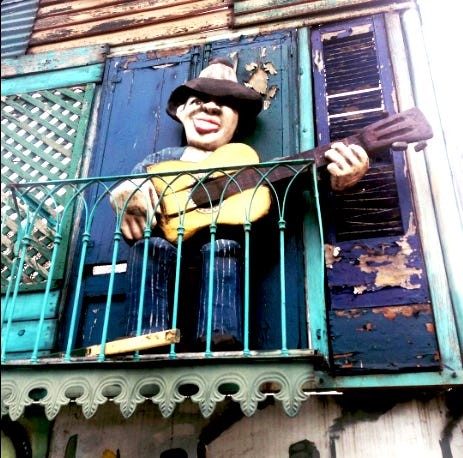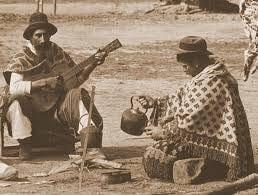This week’s article is full of links to videos. Watch as many or as few as you like.
Sometimes people ask me why I choose to live in Argentina. Well, I have many reasons but here’s a big one: the guitar. “Is Argentinian guitar really that big a deal?” you may ask. Yes. Yes, it is. Today I’m here to tell you that la guitarra argentina is a universe unto itself, and here 5 reasons why.
1. A guitar in every house
There’s a tradition in Argentina (as I’ve mentioned before) that every house has a guitar. We’re talking about a nylon-string Spanish guitar, known here as a guitarra criolla. There’s one in every house and it’s an essential element when it comes to getting together: with just a few friends, some 🧉 mates and one of these six-stringed boxes you can have entertainment for hours on end.
In Argentina you find quite a high percentage of people who know their way around the instrument and can at least sing one or two zambas or a Pink Floyd song; even people who “don’t play guitar” can often strum three chords.
2. Buenos Aires, the capital of tango guitar
When I arrived in Buenos Aires for the first time in 1995, I already played classical and flamenco guitar, but I wanted to find out about tango. And so with very little information to go on (no Internet back then) I managed to stumble upon one of the most important guitarists in tango history, Aníbal Arias. I actually walked up onto the stage after one of his concerts with the municipal tango orchestra and asked him for lessons.
I learned my first couple of tangos, learned about Roberto Grela (the most important guitarist in tango history) and eventually realized that I was studying with a maestro whose photo appeared in tango magazines playing alongside giants like Anibal Troilo.
What I didn’t see on that first trip was that behind the big names in tango guitar were legions of maestros, denizens of the night, laboring away in anonymity.
I say “anonymity” because audiences really didn’t know their names…since the beginning of tango, most records have listed the singer’s name along with “accompanied by guitars.”
And I say “denizens of the night” because the role of a guitarist in tango has always been to accompany singers.
Originally, this meant serenades outside a lady’s window (I’ve met septuagenarians who remember when this was common and I actually hired some when I proposed to my wife). Nowadays it means accompanying amateur and professional singers in shows and peñas, which are kind of like live-band karaoke with two tango guitars.



Even though guitar was one of the founding instruments in tango, most of its activity takes place below the radar. Orchestras and bandoneons inhabit the more glamorous mainstream, attracting larger audiences and dominating the big stages.
What’s so remarkable about the tango guitar underground is the large number of talented guitarists. There are so many here that you never run out: lift up a floor tile, as the saying goes, and you’ll find one.
We have an informal “tango guitar union” with hundreds of members. And even today I know many guitarists whose professional activity is fully dedicated to accompanying singers. Tireless artisans, they work night after night and have learned “the trade” of accompanying singers, known as el oficio, from elders who learned it from their elders.
Nowhere else in the world is there such a wealth of tango guitarists. In fact, most places don’t have any. When I lived in New York I was practically the only one. So, if I have to choose between living amongst zero or hundreds of tango guitarists, I’ll happily take the latter.
3. Wow, the amateurs are good
The Buenos Aires tango scene is not the only place where there’s a ton of hidden guitar talent.
If we take a quick tour of the rest of Argentina we find a shockingly high level of playing by both amateurs and unsung heroes, and it’s all right under the surface, if you know where to look. Divide the map into the four regions of traditional folkloric music, search for videos and you’ll see what I mean: rabbit hole after rabbit hole of excellent homemade content.
I’ll never forget when I first got curious about the music of Western Argentina and starting finding tons of videos like this one, of unnamed virtuosos just hanging out at home or in public and playing the heck out of their guitarras criollas. You can find similar videos from the northwestern region, the northeastern region, and the so-called “southern” region around Buenos Aires province, all featuring surprisingly skilled aficionados.
If you measure wealth in terms of guitar, Argentina is one of the richest countries in the world.
4. The Big Leagues
If the amateurs are that good, just imagine the level of professional talent. Argentina produces world-class classical, tango, jazz and folkloric guitarists, and they’re on display constantly in concert, on TV, on the radio, and in festivals. Just living here keeps me on top of my game.
Here are just a handful of A-list Argentinian guitarists I’ve met, hung out with and learned from:
Hugo Rivas, Rudi Flores, Juan Falú, Ernesto Snajer, Horacio Avilano
5. The Hang
And lest we get too star-struck, here’s something worth mentioning: guitarists tend to be friendly, down to earth, and interested in getting together and hanging out.
I know a guy who opened his own guitar store pretty much so that he could shoot the breeze with other guitarists. And one of my favorite activities is the guitarreada, meaning someone’s making food and we’re all going to get together and play. And when I say we, I mean people from all walks of life and every type of guitarist I’ve mentioned so far. In fact, most of the “big leaguers” cited above are people are happy to get together with just about anyone and play tunes until dawn; I met one or two of them in exactly that type of situation.
Guitarreadas are so special and intriguing that my friend Ignacio Varchausky invited me to organize one every month on his radio show on La2x4 FM, Buenos Aires’ tango station. He wanted to know what goes on when guitarists get together, not on stage but on somebody’s patio, where the magic really happens.
What we do really is unique to our instrument - you’ll never hear of a bunch of double bassists or pianists getting together to play. Maybe it’s our way of recognizing what seems to go unnoticed, our way of celebrating what’s otherwise anonymous.
Guitarra argentina…there’s nothing else like it.
A guitarreada on my rooftop.
Sometimes people say to me that I have two different personalities: one in English, and one in Spanish. I think there’s something to this, and as it turns out much has been written about how languages influence how we think and act.
A pretty wild example of this can be found in Heading South, Looking North, by Ariel Dorfman. It’s the memoir of someone who was born to immigrant parents in Argentina, spent early childhood in New York and adolescence in Chile. Here’s how he describes the effect languages had on various members of his family:
Nor did Spanish report that on its boundaries other languages roamed, waiting for me, greedy languages, eager to penetrate my territory and establish a foothold…It did not hint that English was to the North, smiling to itself, certain that I would have to surrender to its charms eventually…that it was ready to do to me what Spanish itself had done…in fact, to my own parents: wrenched them from the arms of their original language.
I love exploring and experiencing the two languages I know, and I can relate to just a little bit of what Dorfman describes. Have you had experiences with a language changing you⁉️
♫♪𝄞⨾𓍢ִ໋ of the week
Griseta - Ignacio Corsini
Here’s a classic recording of tango guitars and singer Ignacio Corsini, who was one of the “other” great singers during Carlos Gardel’s lifetime. His guitarists were so good that apparently Gardel wanted to steal them from him.
Tachá la doble - LaCruz Heler Nikitoff
This excellent contemporary guitar trio plays classic tangos and also new compositions like this one by Adrián LaCruz.
Como el pampero - Marcos O’Farrell
Since this week is all about guitarra argentina, here’s one more, in the contemporary folkloric category. This is música surera, traditional music from the “southern” or Buenos Aires region, and as you’ll immediately hear, Marcos O’Farrell mixes that with language that sounds more like the 21st century.





For a long time I have been telling about the guitar in Argentina to my US friends. One experience that summarizes the presence of the guitar in Argentina, is what happened to me while travelling in the country. I would meet someone and start talking about music; I would ask them if they played any instrument and they would say "no", then they would pick up a guitar and start playing it without any problems; and this happened more than once. An instrument in their minds is the violin, the bandoneón, the piano; playing the guitar is not playing an instrument, it is like breathing or walking.
As for the guitarists who accompany singers at the peñas, they are absolutely amazing. They know hundreds of songs, both tango and folk music, and they can play them in any key. And they know how much they have to help each singer, as soon as they start singing; if it is a strong singer they can play a more complex accompaniment, but if the singer needs it they play the simplest, most supporting version.
Right now there is a great film made by Yael Szmulewicz, "El sonido de antes", playing at the Gaumont. Anyone interested in guitars should see it.